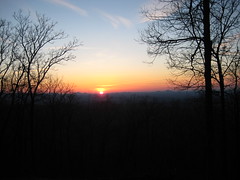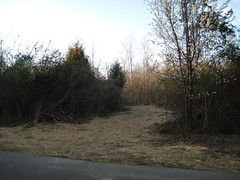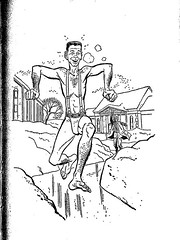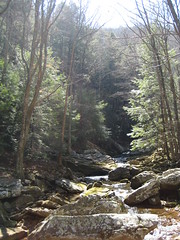This weekend I led an end-to-end hike to Fiery Gizzard. We started at Grundy State Forest and finished at Foster Falls, about 14 miles total. It's a strenuous hike, particularly the first half. The second half is level until the end, when you climb back down into the gorge and right back out.
The water was running high, so there were several wet stream crossings, and the waterfalls were spectacular. As always, the boulder field added to the difficulty of the footing. This is not an easy hike. Most visitors don't hike end to end but turn around at Raven Point and go back on the Dog Hole trail.
This photo was taken at Anderson Falls. This part of the hike is on private land, and the landowners have very recently put in a staircase that goes down to the base of the falls. The stairs aren't fancy, although they do have lights. The slope is very steep and I would not have clambered down it without the stairs - all 169 of them. (Feel the burn!) This photo was taken of us at the base of the falls.
Tuesday, March 31, 2009
Friday, March 27, 2009
Morning mosey
Some of us met to do a morning hike at Radnor Lake. When I left the house, the chance of rain was only 30% and the sky was lightly clouded. But the moment I turned in to the parking lot, the sky broke loose. We hunkered down on the covered porch while debating whether to call the hike off, but eventually the rain ceased and we decided to go for it.
I left my camera in the car in case the respite was only temporary, but in fact our hike remained dry. We took our time; perhaps the rain had thrown us out of our usual rhythm. We started by crossing the spillway over to boathouse. The storm had left a few low clouds behind that crowned the hills behind the lake. We stopped to admire the view, and a tree with each twig tipped in shining water, and an early-blooming lilac. It is wildflower season, and one of our number was an experienced naturalist and named for us rue anemone, dutchmen's breeches, and pussyfoot flower. We saw even more animals out that usual, perhaps because there were fewer people - a dozen each of deer and turtles, including one elderly turtle crossing the road, but also a pileated woodpecker and more common creatures like yellow millipedes with their reek of almonds.
All in all it was a very satisfying hike, and, of course, none of us had our cameras with us to capture it.
I left my camera in the car in case the respite was only temporary, but in fact our hike remained dry. We took our time; perhaps the rain had thrown us out of our usual rhythm. We started by crossing the spillway over to boathouse. The storm had left a few low clouds behind that crowned the hills behind the lake. We stopped to admire the view, and a tree with each twig tipped in shining water, and an early-blooming lilac. It is wildflower season, and one of our number was an experienced naturalist and named for us rue anemone, dutchmen's breeches, and pussyfoot flower. We saw even more animals out that usual, perhaps because there were fewer people - a dozen each of deer and turtles, including one elderly turtle crossing the road, but also a pileated woodpecker and more common creatures like yellow millipedes with their reek of almonds.
All in all it was a very satisfying hike, and, of course, none of us had our cameras with us to capture it.
Monday, March 23, 2009
Hike-Inn weekend
I spent three days at the Hike-Inn at Amicalola Falls State Park in Georgia this weekend. It's a 4.4-mile hike to the Inn - no drivers allowed. Once you've arrived, you can camp in comparative luxury. It's not the Ritz, nor does it pretend to be, but it's a huge step up from a tent or even a primitive cabin. There are showers, heat, home-cooked meals, and entertainment.
On the second day of our stay we hiked up to Springer Mountain, the southern end of the Appalachian Trail. Although I've read about the AT and should have known better, I was still surprised by the trailhead. I expected it to be a three-ring circus swarming with people, surrounded by a parking lot and maybe even a visitors' center. Nope. You have to hike over five miles just to get to Springer Mountain. It was still a busy place - the vernal equinox is the traditional AT through-hike start date, and this was the day after - but it was just a one-ring circus.
On the second day of our stay we hiked up to Springer Mountain, the southern end of the Appalachian Trail. Although I've read about the AT and should have known better, I was still surprised by the trailhead. I expected it to be a three-ring circus swarming with people, surrounded by a parking lot and maybe even a visitors' center. Nope. You have to hike over five miles just to get to Springer Mountain. It was still a busy place - the vernal equinox is the traditional AT through-hike start date, and this was the day after - but it was just a one-ring circus.
Shouldering a burden
This weekend we did a hiking trip that required us to carry our clothes and any non-standard toiletries (i.e., bring your own deodorant), but no camping gear. The lodge we stayed at had a pack scale, and my pack weighed in at 24 pounds. Yikes, I thought: This is heavy enough without everything I'd need to do, say, the Appalachian Trail. One book I have recommends that on a two-week solo summer trip a pack might weigh 31.5 pounds. Pack weights are listed without water or food (which add to the final total by as much as 16 pounds), so after subtracting my 64 oz of water, my pack weighed 20 pounds. That still seems like a lot. So what would I do differently for a real hardcore long trip?
My pack itself weighs 6 pounds, 14 ounces. I like it, but it's not exactly a lightweight pack. I could spend more and shave a pound off that. I carried several things I wouldn't on a long trip - my wallet, my phone, a hardback, some toiletries. I wasn't sashaying around the lodge in mascara, mind you, but I wore deodorant, something most distance hikers dispose with: you stink anyway. My clothing might be slightly lighter, although it's hard to guesstimate because the mix of items would be slightly different. All that, if I'm generous, would take my pack down to 15 pounds. Then I'd have to put back in my tent, sleeping bag, etc.
Backpackers seem obsessed with pack weight and it sounds goofy to anyone who hasn't tried it - "Oooh, I shaved 3 ounces off, I'm so special." But when you actually put the big thing on your back and carry it for a few days, every pound matters and suddenly the obsession makes sense. Even backpackers who aren't ultralight freaks probably give at least passing thought to cutting off unnecessary tags.
My pack itself weighs 6 pounds, 14 ounces. I like it, but it's not exactly a lightweight pack. I could spend more and shave a pound off that. I carried several things I wouldn't on a long trip - my wallet, my phone, a hardback, some toiletries. I wasn't sashaying around the lodge in mascara, mind you, but I wore deodorant, something most distance hikers dispose with: you stink anyway. My clothing might be slightly lighter, although it's hard to guesstimate because the mix of items would be slightly different. All that, if I'm generous, would take my pack down to 15 pounds. Then I'd have to put back in my tent, sleeping bag, etc.
Backpackers seem obsessed with pack weight and it sounds goofy to anyone who hasn't tried it - "Oooh, I shaved 3 ounces off, I'm so special." But when you actually put the big thing on your back and carry it for a few days, every pound matters and suddenly the obsession makes sense. Even backpackers who aren't ultralight freaks probably give at least passing thought to cutting off unnecessary tags.
Thursday, March 19, 2009
New trail at Shelby Bottoms
Earlier this week I discovered a new trail had been added at Shelby Bottoms. It's very short, but anything new at Shelby is exciting.
From the Visitor's Center, take the right fork of the loop. About .2 mile in, directly across from the observation platform on the river, you will see the trail entrance on the left. Don't get too excited by the straw; it's only been laid down for about as much as you can see in the picture here. After that, the trail was made simply by whacking down trees. The soil has not been compacted or anything and is rather marshy. Don't try it at this point unless you are prepared for muddy feet. The trail ends at the meadow at the center of the loop, the meadow that the observation patio looks out on.
What I found most interesting was that all up and down the new trail there were deer prints. I've never seen a deer at Shelby, but they must be there.
From the Visitor's Center, take the right fork of the loop. About .2 mile in, directly across from the observation platform on the river, you will see the trail entrance on the left. Don't get too excited by the straw; it's only been laid down for about as much as you can see in the picture here. After that, the trail was made simply by whacking down trees. The soil has not been compacted or anything and is rather marshy. Don't try it at this point unless you are prepared for muddy feet. The trail ends at the meadow at the center of the loop, the meadow that the observation patio looks out on.
What I found most interesting was that all up and down the new trail there were deer prints. I've never seen a deer at Shelby, but they must be there.
Tuesday, March 17, 2009
Fiery Gizzard scouting hike
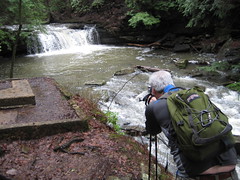 For an upcoming long hike, a few of us did a scouting hike to Fiery Gizzard. First we hiked the Grundy Forest Loop, a 2-mile trail that provides access to the Fiery Gizzard Trail. To the FG trail is either .7 or 1.3 miles; we agreed that the .7-mile segment was much prettier, so there was no value to adding extra mileage. The loop itself is rather nice. There was a great deal more water than the last time we'd been there, and we had a few wet stream crossings.
For an upcoming long hike, a few of us did a scouting hike to Fiery Gizzard. First we hiked the Grundy Forest Loop, a 2-mile trail that provides access to the Fiery Gizzard Trail. To the FG trail is either .7 or 1.3 miles; we agreed that the .7-mile segment was much prettier, so there was no value to adding extra mileage. The loop itself is rather nice. There was a great deal more water than the last time we'd been there, and we had a few wet stream crossings.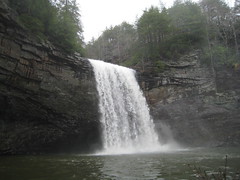 Next we drove to the other end of the FG trail to check out the Foster Falls climbing loop. It's another 2-mile loop created to give rock climbers access to the bluffs. However, in this case the longer portion of the access to FG was much, much better. The bluffs are impressive, and Foster Falls was much larger than I anticipated. This section of the loop is also more difficult, however, so for the upcoming through trip I'll see how everyone feels when we get to the junction.
Next we drove to the other end of the FG trail to check out the Foster Falls climbing loop. It's another 2-mile loop created to give rock climbers access to the bluffs. However, in this case the longer portion of the access to FG was much, much better. The bluffs are impressive, and Foster Falls was much larger than I anticipated. This section of the loop is also more difficult, however, so for the upcoming through trip I'll see how everyone feels when we get to the junction.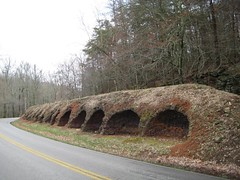 Our third short hike was only 1.5 miles and mostly flat, but it was still intriguing. The Lone Rock Trail at Grundy Lakes State Park circles the lake and passes by many of the old coke ovens. These are left over from a coal mining operation of the late 1800s. It was run with convict labor, and it sure doesn't look like it would have been fun to operate a hot fire in the summertime.
Our third short hike was only 1.5 miles and mostly flat, but it was still intriguing. The Lone Rock Trail at Grundy Lakes State Park circles the lake and passes by many of the old coke ovens. These are left over from a coal mining operation of the late 1800s. It was run with convict labor, and it sure doesn't look like it would have been fun to operate a hot fire in the summertime.Sunday, March 15, 2009
Reading the top 10 translated novels
I started off with Robert Bolaño's 2666, a very long novel in five sections. One reviewer on Amazon gave the book one star because the fourth section was filthy, in their mind, and "unless you like reading 'anally raped' over and over you shouldn't bother," they said. Now, this part of the book is the hardest to read and by far the longest, but what makes it difficult is the nature of the crimes described, not the manner of the description. It's not snuff that describes violence with pleasure. It's detached, clinical, in the manner of a police report, and technical rather than graphic. That Bolaño could come up with this doesn't suggest he has a depraved mind - the crimes in the book are based on a series of real murders - so much as it suggests that the world around us is, at times, depraved. (Still, if you prefer not to read about this sort of topic, aesthetically or morally, fine, but then you're something of an idiot to pick up a book about the murder of hundreds of women in the first place.)
The fourth section ("The Part About the Crimes") is wonderfully effective at inducing shame. In the first three parts, I found myself despising the characters to some degree because all these terrible crimes are going on around them, and they pay little to no attention to them. Then in the fourth section, I began to wish I was reading about anything else. The crimes and the larger milieu of Santa Teresa, with its corruption and poverty, become overwhelming, and I wanted to go back to reading about boxing and Pynchonesque authors. Of course, then I could no longer look down on the characters that momentarily deplored the crimes before turning to something else.
The second book I read was one I didn't have high hopes for - Attila Bartis' Tranquility promised to be in the vein of Philip Roth. It's about a man who lives with his crazy homebound mother, a former actress. I unexpectedly enjoyed it, although after the fact I was bemused by the jacket description of the work as laugh-out-loud funny. It never occurred to me to laugh - not because it was unfunny, like Larry the Cable Guy, but because for the most part it didn't occur to me it was supposed to be chortle-inducing.
I then went back to Bolaño for Nazi Literature in the Americas. If you love Lambshead, you'll like Nazi Literature. It's an encyclopedia of (fictional) fascist authors from the North America, Central America, and South America. (No Canadians though.) It's a small work compared to 2666, but still fun.
After reading three books in a row about authors, I was ready for something else and turned to Voice Over by Céline Curiol. I wasn't expecting to like it, and I liked it even less than I expected. It is no doubt a failing on my part, but I'd much rather sympathize with a main character who is something vile like a murderer than someone passively amoral. I have no patience for characters like our protagonist here, a needy woman screwing up her own life, someone I don't like or understand spending time with other unlikable people in tacky situations. And I really don't want to be stuck in her head for 250 pages of stream of consciousness. After only 25 pages I would prefer to go back to section four of 2666. I might have to put this one down and come back.
The fourth section ("The Part About the Crimes") is wonderfully effective at inducing shame. In the first three parts, I found myself despising the characters to some degree because all these terrible crimes are going on around them, and they pay little to no attention to them. Then in the fourth section, I began to wish I was reading about anything else. The crimes and the larger milieu of Santa Teresa, with its corruption and poverty, become overwhelming, and I wanted to go back to reading about boxing and Pynchonesque authors. Of course, then I could no longer look down on the characters that momentarily deplored the crimes before turning to something else.
The second book I read was one I didn't have high hopes for - Attila Bartis' Tranquility promised to be in the vein of Philip Roth. It's about a man who lives with his crazy homebound mother, a former actress. I unexpectedly enjoyed it, although after the fact I was bemused by the jacket description of the work as laugh-out-loud funny. It never occurred to me to laugh - not because it was unfunny, like Larry the Cable Guy, but because for the most part it didn't occur to me it was supposed to be chortle-inducing.
I then went back to Bolaño for Nazi Literature in the Americas. If you love Lambshead, you'll like Nazi Literature. It's an encyclopedia of (fictional) fascist authors from the North America, Central America, and South America. (No Canadians though.) It's a small work compared to 2666, but still fun.
After reading three books in a row about authors, I was ready for something else and turned to Voice Over by Céline Curiol. I wasn't expecting to like it, and I liked it even less than I expected. It is no doubt a failing on my part, but I'd much rather sympathize with a main character who is something vile like a murderer than someone passively amoral. I have no patience for characters like our protagonist here, a needy woman screwing up her own life, someone I don't like or understand spending time with other unlikable people in tacky situations. And I really don't want to be stuck in her head for 250 pages of stream of consciousness. After only 25 pages I would prefer to go back to section four of 2666. I might have to put this one down and come back.
Thursday, March 12, 2009
Jobs
Marywood University: Assistant/associate professor in higher education.
Tuesday, March 10, 2009
God bless you each and every one
I'm back with another book from the dustbins of the mid-century. This time it's a book whose title caught my eye while I was searching for a different volume: God Bless Our Queer Old Dean by W. Lee Storrs. The book is a non-technical easy read on the job of the dean of student affairs, at least as that job stood in 1959.
Usually, the 1950s don't feel that long ago to me, but this book is practically a museum piece. The are of "deaning" as described by this book sounds nearly as quaint as does its description of colonial student affairs. Mentally, it is not much more of a stretch to imagine the days when students were ordered by social standing and presidents directly meted out corporal punishment than it is to imagine separate Deans of Men and Women overseeing a student affairs apparatus so small that students have personal relationships with the appropriately gendered dean.
But back to the fun stuff: Let's start with the title. Now poor Dean Storrs can't be blamed for failing to anticipate the newer meaning of "queer," and in fact the preface reassures one that he doesn't mean that sort of queer by listing "whether the suspected homosexual should be immediately separated from the student body or given therapy" as one of the many dilemmas deans face. Nevertheless, the vigorous manhood of mid-century just doesn't inflect the same way now. Much of the sentiment belong more to the era of Kipling and Baden-Powell than to Sputnik, and the author's irrationally exuberant slang would be right at home in the mouth of one of Sinclair Lewis' Rotarians.
The illustrations add to the reading experience - notice my personal favorite above. In addition to these charming sketches, there are also prosy sketches designed to illustrate the challenges of deaning. One tells the story of a student who reported seeing pancakes in his dresser drawer. After referring him to first a counselor and then a psychiatrist to no avail, the dean looks in said dresser and finds - pancakes. A friend of mine remarked that this raises more questions than it answers, not the least of which is why someone had stored delicious breakfast foods in a bureau.
But the author (and I) have saved the best for last. Below, I present the final two paragraphs, which I swear I have not tampered with in any way. *SPOILER ALERT* After discussing the increased permissiveness on college campuses, which today we recollect as the last gasps of in loco parentis, Storrs concludes:
"The undergraduate of the next decade undoubtedly faces a harder grind, tougher competition, severer stricture, and as the avalanche of collegians such as has never been known in any country in any age descends upon the campus, most of the flummery about the permissive attitude and the progressive approach will be lost in the shuffle. Readjustment will take a long time, but it is clear that a new era or rigor and regulation is coming in, and the dean will be called on once again to swing the strap.
"Bend over, son."
Usually, the 1950s don't feel that long ago to me, but this book is practically a museum piece. The are of "deaning" as described by this book sounds nearly as quaint as does its description of colonial student affairs. Mentally, it is not much more of a stretch to imagine the days when students were ordered by social standing and presidents directly meted out corporal punishment than it is to imagine separate Deans of Men and Women overseeing a student affairs apparatus so small that students have personal relationships with the appropriately gendered dean.
But back to the fun stuff: Let's start with the title. Now poor Dean Storrs can't be blamed for failing to anticipate the newer meaning of "queer," and in fact the preface reassures one that he doesn't mean that sort of queer by listing "whether the suspected homosexual should be immediately separated from the student body or given therapy" as one of the many dilemmas deans face. Nevertheless, the vigorous manhood of mid-century just doesn't inflect the same way now. Much of the sentiment belong more to the era of Kipling and Baden-Powell than to Sputnik, and the author's irrationally exuberant slang would be right at home in the mouth of one of Sinclair Lewis' Rotarians.
The illustrations add to the reading experience - notice my personal favorite above. In addition to these charming sketches, there are also prosy sketches designed to illustrate the challenges of deaning. One tells the story of a student who reported seeing pancakes in his dresser drawer. After referring him to first a counselor and then a psychiatrist to no avail, the dean looks in said dresser and finds - pancakes. A friend of mine remarked that this raises more questions than it answers, not the least of which is why someone had stored delicious breakfast foods in a bureau.
But the author (and I) have saved the best for last. Below, I present the final two paragraphs, which I swear I have not tampered with in any way. *SPOILER ALERT* After discussing the increased permissiveness on college campuses, which today we recollect as the last gasps of in loco parentis, Storrs concludes:
"The undergraduate of the next decade undoubtedly faces a harder grind, tougher competition, severer stricture, and as the avalanche of collegians such as has never been known in any country in any age descends upon the campus, most of the flummery about the permissive attitude and the progressive approach will be lost in the shuffle. Readjustment will take a long time, but it is clear that a new era or rigor and regulation is coming in, and the dean will be called on once again to swing the strap.
"Bend over, son."
Monday, March 9, 2009
Spring break part II
It's spring break season, and the Cumberland Trail Conference is one of the many hosts of the Alternative Spring Break program. For five weeks, groups of college students are traveling to Soddy-Daisy to help build trail. I went out to help cook for the group of 70-some people (four schools plus CTC staff and volunteers) during the second week of the program.
The days were actually pretty long, and some days I never made it outside the building. But Wednesday was our day off (well, theoretically - we spent the morning shopping for food), and so that afternoon we did a short hike on the Possum segment of the trail. This photo was taken from the bridge we hiked to. This bridge is actually one that my hiking club helped build last summer. The really sad thing is that I didn't recognize it with more water, an approach from the other side, and a completed bridge!
I left on Saturday to come back to Nashville. Time to get to work.
The days were actually pretty long, and some days I never made it outside the building. But Wednesday was our day off (well, theoretically - we spent the morning shopping for food), and so that afternoon we did a short hike on the Possum segment of the trail. This photo was taken from the bridge we hiked to. This bridge is actually one that my hiking club helped build last summer. The really sad thing is that I didn't recognize it with more water, an approach from the other side, and a completed bridge!
I left on Saturday to come back to Nashville. Time to get to work.
Sunday, March 8, 2009
Spring break part I
I left town last Saturday, heading south on I-5 to Old Stone Fort State Park. After seeing a freeway sign for "wind powered coffee" I stopped here for a drink. It wasn't much farther to the park, which has a very misleading name. Settlers saw the rock walls and assumed the area was a fort, but archeologists have since decided otherwise. I wouldn't even have known there were walls; they were never tall, and time has broken them down and covered them so they just look like small mounds. The wall itself is at the top of a plateau-topped bluff surrounded by the Duck River.
The main trail that circles the walls is just 1.5 miles long. There are several optional excursions down to see waterfalls and the river that are difficult to strenuous, making the total distance I hiked 2.6 miles. Most hikes this distance don't offer much scenery - or they are overrun with crowds. This one was neither. It was a very pleasant surprise.
After this break, I got back on the road to Soddy-Daisy where the Cumberland Traiil Conference was camped out.
The main trail that circles the walls is just 1.5 miles long. There are several optional excursions down to see waterfalls and the river that are difficult to strenuous, making the total distance I hiked 2.6 miles. Most hikes this distance don't offer much scenery - or they are overrun with crowds. This one was neither. It was a very pleasant surprise.
After this break, I got back on the road to Soddy-Daisy where the Cumberland Traiil Conference was camped out.
Saturday, March 7, 2009
Jobs
[crickets]
I've been out of town for spring break; details will be posted after I get my pictures uploaded. In the meantime, here is a new job announcement.
University of Georgia: Assistant or Associate Professor at the Institute of Higher Education.
I've been out of town for spring break; details will be posted after I get my pictures uploaded. In the meantime, here is a new job announcement.
University of Georgia: Assistant or Associate Professor at the Institute of Higher Education.
Sunday, March 1, 2009
Read the world
Every now and then I start to feel guilty about what I read - or rather, about what I don't read. (I make no apology for wanting to find out what happens to Dalziel in the final Bastion Club novel. Many graduate students say they read nothing for pleasure at all and claim to long for the day they graduate and can pick up fiction again. Yet I know how much television many of these students watch. I'm not arguing against TV; my point is simply that we all manage to make time for our own brain candy, and mine happens to be fiction that does not have the imprimatur of literature instead of TV. I feel no more guilt over this than do my friends who watch Lost or Double Shot at Love. But I digress.) To assuage this guilt I periodically resolve to read more of a certain type of book or another - more African-American authors or more classics, perhaps.
My latest guilt-wave was set off by seeing this article that laments how little translated fiction Americans read. The author of this article managed to stay on my good side by devoting more space to citing statistics than to implying that America was a race of barbarians, and I resolved to do my part to fortify American reading.
Thus, this month I am going to try to read the top 10 translated novels of 2008. Step one was finding them. I started my quest at the Nashville Public Library, which had two of the books (the Bolaños), although one had a long request queue. Two more were on order. I then looked for the remaining eight at Vandy - which had one, but it was at the bindery. No wonder Americans don't read this stuff - we can't FIND it!
We'll see if I succeed in this endeavor. It works out to a book every three days, and I don't know if that's sustainable, not when I have other things to read as well. (You know, that pesky dissertation, that kind of thing.)
My latest guilt-wave was set off by seeing this article that laments how little translated fiction Americans read. The author of this article managed to stay on my good side by devoting more space to citing statistics than to implying that America was a race of barbarians, and I resolved to do my part to fortify American reading.
Thus, this month I am going to try to read the top 10 translated novels of 2008. Step one was finding them. I started my quest at the Nashville Public Library, which had two of the books (the Bolaños), although one had a long request queue. Two more were on order. I then looked for the remaining eight at Vandy - which had one, but it was at the bindery. No wonder Americans don't read this stuff - we can't FIND it!
We'll see if I succeed in this endeavor. It works out to a book every three days, and I don't know if that's sustainable, not when I have other things to read as well. (You know, that pesky dissertation, that kind of thing.)
Subscribe to:
Posts (Atom)

